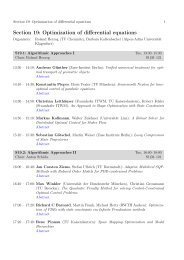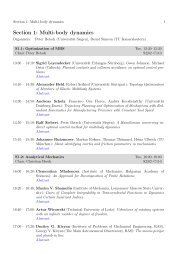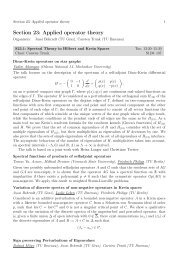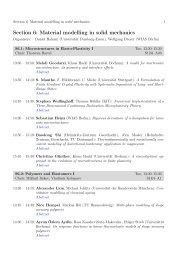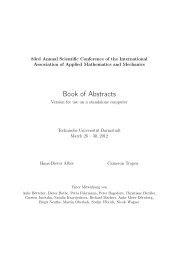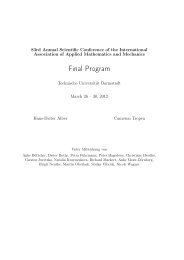Section 6: Material modelling in solid mechanics - GAMM 2012
Section 6: Material modelling in solid mechanics - GAMM 2012
Section 6: Material modelling in solid mechanics - GAMM 2012
You also want an ePaper? Increase the reach of your titles
YUMPU automatically turns print PDFs into web optimized ePapers that Google loves.
24 <strong>Section</strong> 6: <strong>Material</strong> <strong>modell<strong>in</strong>g</strong> <strong>in</strong> <strong>solid</strong> <strong>mechanics</strong><br />
<strong>in</strong>dividual materials constituents. It was found that for the considered composites have place the<br />
additional peak damp<strong>in</strong>g properties, which is realized for very small thicknesses of the viscoelastic<br />
phase. This peak is still about a factor 20 or so compared to the loss modulus of the pure matrix.<br />
We demonstrated that by <strong>in</strong>troduc<strong>in</strong>g th<strong>in</strong> layers of a viscoelastic material, one can significantly<br />
<strong>in</strong>crease the loss characteristics of discrete morphology multiphase materials. The layered fibers<br />
composites are also considered. It is shown that for such materials may be implemented at the<br />
same time as high elastic properties, and abnormally high damp<strong>in</strong>g properties.<br />
[1] A.A.Gusev , S.A. Lurie, Loss amplification effect <strong>in</strong> multiphase materials with viscoelastic<br />
<strong>in</strong>terfaces. Macromolecules (2009) 42,14, 5372 – 5377.<br />
Model<strong>in</strong>g of composite structural elements made from aramid fiber us<strong>in</strong>g the method<br />
of features objects<br />
Michał Majzner, Andrzej Baier (Silesian University of Technology)<br />
The use of modern materials such as composite materials, enabl<strong>in</strong>g the production of new or modify<strong>in</strong>g<br />
exist<strong>in</strong>g design solutions, improve their technical characteristics, while use <strong>in</strong> the process<br />
of design and eng<strong>in</strong>eer<strong>in</strong>g and manufactur<strong>in</strong>g, will allow the modification of endurance, physical<br />
and chemical properties to match the features and functionality that are comply with. In research<br />
studies, it is proposed to systematize and formalize elementary objects <strong>in</strong> the context of model<strong>in</strong>g<br />
and fabrication of objects created on the basis of structural fiber composites. Application of features<br />
objects methods was shows on an example of model<strong>in</strong>g the structural element, <strong>in</strong> the form<br />
of an exist<strong>in</strong>g manufactured from steel, which was modified and converted with aramid fiber. It<br />
was necessary to carry out research <strong>in</strong> the form of numerical analysis, exam<strong>in</strong><strong>in</strong>g the strength of<br />
the modified object.<br />
On the fibres shape effect for non-l<strong>in</strong>ear and unidirectional stationary heat conduction<br />
<strong>in</strong> two-phase hollow cyl<strong>in</strong>der with radially graded material properties<br />
Piotr Ostrowski (Technical University of Lodz)<br />
The ma<strong>in</strong> aim of this paper is to consider unidirectional and stationary heat conduction <strong>in</strong> the<br />
<strong>in</strong>fnite two-phase hollow cyl<strong>in</strong>der with temperature dependent material properties. The determ<strong>in</strong>istic<br />
microstructure of this composite is periodic (for a fixed radius) along the angular axis<br />
and has slowly vary<strong>in</strong>g effective properties <strong>in</strong> the radial direction. Therefore, we deal here with<br />
a special case of functionally graded materials, FGM, c.f. Suresh, Mortensen (1998). One of the<br />
components is called fibre, which is arranged <strong>in</strong> considered hollow cyl<strong>in</strong>der with circular pattern.<br />
The physical phenomenon of the heat transfer is described by well known Fourier’s equation<br />
c ˙ θ − ∇(K∇θ) = 0, (1)<br />
which conta<strong>in</strong>s temperature dependent (<strong>in</strong> this case), highly oscillat<strong>in</strong>g and discont<strong>in</strong>uous coefficients<br />
of K = K(θ) - heat conduction tensor, and c = c(θ) - specific heat. To this macroscopic<br />
model the tolerance averag<strong>in</strong>g approximation will be used, cf. Wozniak, Wierzbicki (2000). The<br />
general approach to the description of longitud<strong>in</strong>ally graded stratified media can be found <strong>in</strong><br />
[Wozniak, Michalak, Jedrysiak 2008]. The fibres width function g = g(r) of radius r will be exam<strong>in</strong>ed<br />
and its effects on the temperature field. The averaged differential equation has smooth<br />
and slowly vary<strong>in</strong>g coefficients, hence <strong>in</strong> some special cases, for boundary value problem, analytical<br />
solution can be obta<strong>in</strong>ed. In other cases, numerical methods have to be used. This model<br />
takes <strong>in</strong>to account the effect of microstructure size on the overall heat transfer behaviour.



